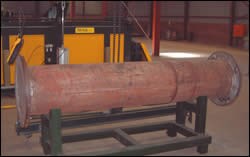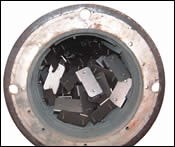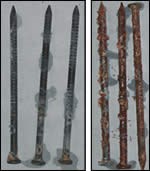Approaching Zero Discharge
A look at an alternative zinc coating process
There are a variety of zinc coating technologies for corrosion protection of metal surfaces, the most common being hot-dip galvanizing and zinc electroplating.
Thermo-diffusion of a zinc coating onto a metal substrate is a newer process that forms a zinc alloy with the substrate. The U.S. Environmental Protection Agency’s T. David Ferguson recently conducted a detailed inspection of an overseas manufacturing facility using thermo-diffusion and of parts produced using the process. He subsequently authored a technical paper and presented information at SUR/FIN 2006 on the results of his visit.
EPA evaluated the potential for emissions, monitored internal air at the plant and compared the corrosion resistance of thermal diffusion-coated parts with parts produced using other zinc plating processes. The results were impressive, and it appears the process does approach zero discharge. There are no water emissions from the plant and no drains in the plant, and all sludge containing used zinc powder from rinse and passivation tanks is recycled. Emissions from the pretreatment and degreasing operations were minimal. These stages were seldom used in the plant, because the thermal diffusion process can handle parts with light oils and light rust. As a result, pretreatment is not necessary for most parts entering the plant.
Based on salt-spray test results, the process also provides corrosion protection exceeding that of hot-dip or electrogalvanizing processes. Corrosion test results are discussed in more detail later in this article.
How It Works
Thermo-diffusion is similar to a process known as Sherardizing or mechanical plating, which provides some of the same benefits. The process can coat fasteners and other small and medium-sized steel or cast iron parts with a required thickness of coating above 15 μm.
Thermo-diffusion technology uses a proprietary zinc powder that is baked into the product in a sealed oven. Unused powder is recycled back into the process, resulting in near-zero discharge. The process produces coatings that can adhere to lightly rusted parts with light oils without pretreatment and provides salt spray corrosion protection two to four times higher than hot-dip or electrogalvanizing. It is also said to be more cost-effective than conventional galvanizing methods.
As previously stated, pretreatment isn’t required for most fasteners or other parts. Most of the parts come to the plant lightly oxidized and contain a light oil that burns off before the zinc diffusion takes place. With zinc electroplating or hot-dip galvanizing, these same parts would have to be cleaned for proper coating adhesion and corrosion resistance. Heavily oxidized parts are shot blasted before the process.
Parts that contain heavy oil or grease or parts with a geometry that traps oils must be degreased in an alkaline cleaner. Degreasing does have emissions associated with it; however, emissions from this processing step are minimized by the fact that most parts don’t require any pretreatment. In the pilot plant, they skim about one liter of oil per month off the degreaser unit. The alkaline cleaner will ultimately have to be disposed in a proper manner.
Next, parts and the proprietary zinc powder are loaded into a container that’s sealed before placing it in the oven. The container stays in the oven for approximately 3–4 hrs at 450°C, then is cooled at room temperature for 3–4 hrs. These steps require no outside vents or stacks.
After cooling, the container is opened and parts are dumped on a vibratory conveyor belt. Excess zinc powder is captured by means of a vacuum with filter and recycled.
This step involves use of an outside vent from the dust filtering process. The filtering system used in the pilot plant is rated to take out 100% of particles 0.5 μm and larger. Particle size of the zinc powder is >30 μm.
From the conveyor belt, parts are dumped to a vibratory finishing machine for rinsing, polishing and passivation. Here, the parts are spray rinsed with water and polished with porcelain media. The rinse is about 4 min long at room temperature. Rinse water is pumped from a separate tank into and out of the circular vibratory machine. Then, zinc phosphate is pumped into and out of the finishing machine with the porcelain chips for 7 min at room temperature.
Plant personnel remove zinc solids from the water rinse and zinc phosphate tanks daily using a centrifugal filter. Damp zinc powder cake is recycled with the rest of the used powder back into virgin product. The water and phosphate tanks are periodically drained and de-sludged. Sludge is also saved for recycle. Zinc phosphate is pumped back to the original tank with makeup water from the rinse water in the other holding tank, then adjusted for concentration. The balance of the rinse water is pumped back into the rinse tank with fresh water makeup. There are no air stack emissions or water discharges in this step.
After mechanical finishing, parts are dumped to a hot rinse basket at 55°C, then air-dried and given a second passivation using a silica solution at 55°C. This is followed by conveying to a final heated dry step. Again, there are no air stack emissions or water discharges in this step, and all sludge is recycled back into the process.
Plant Air Monitoring
Internal air in the plant was tested for zinc using a small pump and filter cassette that sampled air at a rate of 2 l/min for 8 hrs before the filter was analyzed for zinc. Samples were collected at various points along the manufacturing process, including:
- Loading of parts and zinc powder into the ovens
- The oven area
- Unloading of parts for rinsing
- Rinsing/sealant/drying area
- Pretreatment (degreasing and shot blast) area.
Air in each area was tested on two consecutive days. Sample data showed that the total zinc concentrations in the plant were well within OSHA limits for zinc oxide in both fume and total dust forms. They were also within limits of all other OSHA-regulated zinc compounds (zinc chloride and zinc stearate).
To ensure air sample data quality, collection pumps were calibrated before and after each run. A field blank was collected each day by opening the filter cassette for 3 sec and re-sealing the cassette.
In the lab, filter samples were digested with nitric acid and analyzed for zinc using inductively coupled plasma spectrometry. Laboratory QA/QC checks included a laboratory reagent blank, a laboratory fortified blank, and matrix spikes. Also, continuing calibration blanks and continuing calibration verification standards were analyzed at the beginning of a run, after eight samples, and at the end of the run.
The Finish
The standard appearance produced by zinc thermo-diffusion is a flat gray finish that’s not shiny like the finish produced by hot-dip galvanizing. Thermo-diffused zinc is also available in black, green and light gray, where the color is diffused into the alloy. The product can also be dyed, painted or powder coated to produce more final colored finishes.
Although no suitable international standards currently exist for testing the adhesion of Sherardized coatings on fabricated products, adhesion between zinc and basis metal is generally not an issue—good bonding between coating and substrate is characteristic of the Sherardizing process.
The process can work with a variety of part geometries. If air can get in a crack or crevice, then a part can be coated. Parts that would normally ‘‘acid bleed’’ due to fine cracks or crevices can be coated, and the process also facilitates coating of internal diameters as well as fine threads.
Certain workpieces (an example would be hinges), where entrapment of acid aggravates bleed-out during and after other types of plating, don’t have this issue with the zinc thermo-diffusion process. In one forged steel part with a very tight crack that normally might acid bleed, the coating produced by zinc thermo-diffusion managed to get into the crack and coat the part on the surface inside the crack. Based on results from this part, coating thickness in very tight spaces is reduced by an average of about 20%.
The thermo-diffusion coating can be applied at a range of thicknesses from approximately 15–100 μm at 5-μm intervals.
Corrosion Testing
In an attempt to compare the corrosion resistance of zinc thermo-diffusion coated parts with that of hot-dip and electrogalvanized components, samples from all three processes were subjected to salt spray testing according to ASTM B 117. Samples were in the form of fasteners (specifically, screws and nails).
Several tests were performed. These included testing of the products by themselves, screws used with galvanized sheet metal fastening, screws used with ACQ .40 PCF lumber, nails used with ACQ lumber and nails with varying degrees of rust prior to coating using zinc thermo-diffusion.
The purpose of testing fasteners used with lumber and sheet metal was to try to assess corrosion performance of thermo-diffusion zinc in “real world” conditions where the coating could be scraped or worn from use. Parts were tested in the final condition—with light rust that was not removed before thermo-diffusion processing—to try to obtain some indication of the amount of light corrosion that the thermo-diffusion process can handle without impacting corrosion resistance of finished parts.
Test specimens were compared and photographed every 50–250 hrs during testing. Results showed that corrosion performance of the thermo-diffusion coated parts directly exposed to the salt spray exceeded that of hot-dip galvanized and electrogalvanized parts in most cases.
For example, first appearance of red rust (FRR) on thermo-diffusion coated nails with a coating thickness of 30–50 μm was after more than 1,500 hrs of exposure. This compared very favorably to hot-dip galvanized parts with coating thickness of 55–75 μm, which showed FRR at 167 hrs. Results relating to the fastener imbedded in the ACQ lumber were inconclusive and may require development of a testing protocol.
In a comparison of salt-spray resistance of nails with very similar coating thickness ranges (55–85 μm thermo-diffusion versus 55–90 μm double hot-dip), FRR was 450 hrs for the thermo-diffusion parts versus 117 hrs for the hot-dip nails. Nails with a very thick thermo-diffusion coating (175–250 μm) lasted 3,108 hrs before FRR. A photo shows relatively light rust and corrosion even after more than 4,200 hrs of salt-spray exposure.
Yet another round of salt-spray testing compared corrosion performance of nails that were corroded when coated using the thermo-diffusion process to hot-dip galvanized nails with coating thickness of 15–50 μm. Although the thickness of the thermo-diffusion coating was unknown, testing demonstrated that coating of rusty parts using the process does not appear to impact corrosion performance of the finished components. Time to FRR for the thermo-diffusion coated nails was 1,500 hrs, compared with 267 hrs to FRR for the hot-dip nails.
Further testing showed that thermo-diffusion coated screws attached to galvanized sheet metal showed FRR at 450 hrs, compared with 117 hrs for zinc electroplated screws attached to galvanized sheet. A photo comparison after 1,500 hrs of salt spray shows a significant difference in the severity of corrosion experienced under these conditions.
Thermo-diffusion coated parts were not tested for hydrogen embrittlement, because the process doesn’t give rise to conditions that might result in hydrogen embrittlement.
The idea is that hydrogen embrittlement may not be a problem because there is usually no acid cleaning involved in processing and because the standard remedy for potential hydrogen embrittlement is a heat treatment that is part of the thermo-diffusion process.
This article is based on the paper “Approaching Zero Discharge: In Plant Evaluation Of Zinc Thermal Diffusion Coating Technology, Phase I,” which appeared in the journal Clean Technologies and Environmental Policy; and on a presentation made at SUR/FIN 2006. The original paper and presentation are both by T. David Ferguson, Civil Engineer, National Risk Management Research Laboratory, U.S. Environmental Protection Agency (Cincinnati, OH).
Related Content
Hubbard-Hall Acquires BioConversion Technology
The acquisition adds experience and biologics to the AquaPure product line.
Read MoreExplore Cleaning Chemistry, Metal Finishing Applications and Wastewater Treatment Solutions
Hubbard-Hall Celebrating 175 years of excellence, Hubbard-Hall presents chemistry and equipment.
Read MoreNASF/AESF Foundation Research Project #121: Development of a Sustainability Metrics System and a Technical Solution Method for Sustainable Metal Finishing - 15th Quarterly Report
This NASF-AESF Foundation research project report covers the twelfth quarter of project work (October-December 2023) at Wayne State University in Detroit. In this period, our main effort focused on the development of a set of Digital Twins (DTs) using the Physics-Informed Neural Network (PINN) technology with application on parts rinsing simulation.
Read MoreTop 5 Areas to Consider Automation of Plating Operations
Automation for finishing operations can lead to improvements in process time, repeatability and consistency of quality. Yet, processes that make sense to explore for these operational efficiencies may not always be readily apparent.
Read MoreRead Next
Delivering Increased Benefits to Greenhouse Films
Baystar's Borstar technology is helping customers deliver better, more reliable production methods to greenhouse agriculture.
Read MoreEpisode 45: An Interview with Chandler Mancuso, MacDermid Envio Solutions
Chandler Mancuso, technical director with MacDermid Envio discusses updating your wastewater treatment system and implementing materials recycling solutions to increase efficiencies, control costs and reduce environmental impact.
Read MoreA ‘Clean’ Agenda Offers Unique Presentations in Chicago
The 2024 Parts Cleaning Conference, co-located with the International Manufacturing Technology Show, includes presentations by several speakers who are new to the conference and topics that have not been covered in past editions of this event.
Read More















.jpg;maxWidth=300;quality=90)









